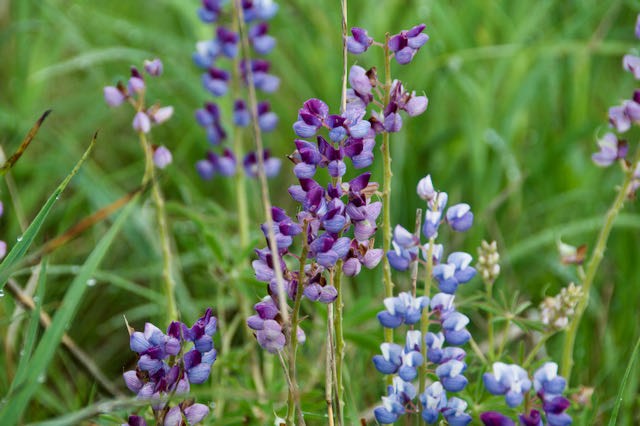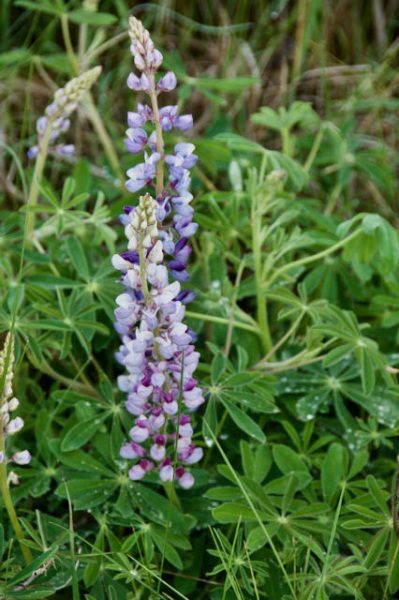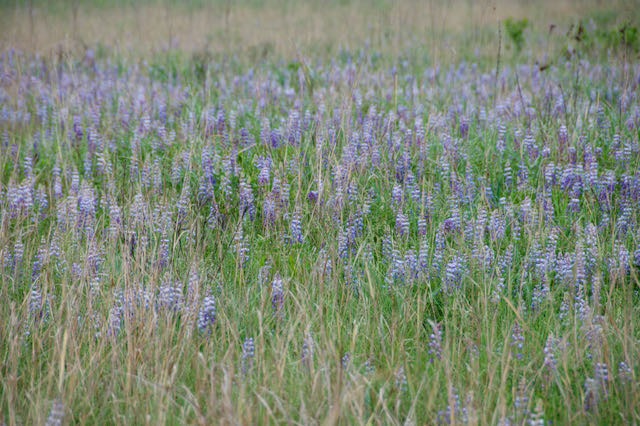sundial lupine
Lupinus perennis
Description:
Sundial lupine are well known in Wisconsin’s central sand counties and the Northern Highlands. It loves very sandy, open and sunny (sometimes partly shaded) borders or clearings in open, dry black oak-Hill’s oak-jack pine woods, oak barrens, sandy prairies, roadsides and old fields, and infrequently on sandstone bluffs and ridges. Sundial lupine, also called wild lupine, are the primary host plant for the federally endangered Karner Blue butterfly (Lycaeides melissa sub. samuelis). They are also the larval host of the Frosted Elfin butterfly (Callophrys irus), which is listed as threatened on the Wisconsin Natural Heritage Inventory list.
Growing Sundial Lupine:
Sundial lupine really like it sandy and prefer acidic over alkaline soil. They spread easily from seed in the right location. The NRCS Plant Guide provides tips for successfully growing lupine on your property.
Details:
wild lupine
| USDA Symbol: | Common Name: | Scientific Name: |
|---|---|---|
| LUPE3 | sundial lupine | Lupinus perennis |
ITIS TSN: 26091
Category: Dicot
Taxonomy
Kingdom: Plantae
Subkingdom:
Super Division: Spermatophyta
Division: Magnoliophyta
Subdivision:
Class: Magnoliopsida
SubClass: Rosidae
Order: Fabales
Family: Fabaceae
Counties: Adams, Barron, Bayfield, Brown, Buffalo, Burnett, Chippewa, Clark, Columbia, Crawford, Dane, Douglas, Dunn, Eau Claire, Grant, Green, Iowa, Jackson, Juneau, Kenosha, La Crosse, Lafayette, Lincoln, Manitowoc, Marinette, Marquette, Menominee, Milwaukee, Monroe, Oconto, Outagamie, Pepin, Pierce, Polk, Racine, Richland, Rock, Sauk, Shawano, St. Croix, Vernon, Vilas, Washburn, Waukesha, Waupaca, Waushara, Wood
| Duration: | Growth Habit: | Native Status: |
|---|---|---|
| Perennial | Forb/herb | L48(N)CAN(N)SPM(I) |
| NR40 Listed Plant | Noxious Weed: | Invasive Species (NR40): | Threatened/Endangered: | WI Natural Heritage Index: | Wetland Status |
|---|---|---|---|---|---|
Carbon to Nitrogen Ratio:
Conspicuous Fall Color: No
Fire Resistant: No
Flower Color: Blue
Conspicuous Flower: Yes
Foliage Color: Green
Foliage Light Porosity Summer:
Fruit/Seed Color: Brown
Growth Form: Bunch
Height at Base Age (Max):
Known Alelopath:
Leaf Retention: No
Lifespan: Moderate
Re-sproutability:
Toxicity: Slight
Height (min): 8
Height (max): 24
Leaf Type:
Leaf Arrangement:
Leaf Shape:
Vein Pattern:
Adapted to Coarse Textured Soils: Yes
Adapted to Medium Textured Soils: Yes
Adapted to Fine Textured Soils: No
Hedge Tolerance: None
Moisture Use: Low, Medium
pH (Minimum): 6.8
pH (Maximum): 7.2
Planting Density per Acre, Minimum:
Planting Density per Acre, Maximum:
Precipitation (Minimum):
Precipitation (Maximum):
Root Depth, Minimum (inches):
Plant Spacing (min): 8
Plant Spacing (max): 12
| Bloom Period: | Commercial Availability: | Fruit/Seed Abundance: |
|---|---|---|
| Late Spring | Routinely Available |
| Fruit/Seed Period Begin: | Fruit/Seed Period End: | Fruit/Seed Persistence: |
|---|---|---|
| Propogated by Bare Root: | Propogated by Bulbs: | Propogated by Container: |
|---|---|---|
| Propogated by Corms: | Propogated by Cuttings: | Propogated by Seed: |
|---|---|---|
| Propogated by Sod: | Propogated by Sprigs: | Propogated by Tubers: |
|---|---|---|
| Seeds per Pound: | Seed Spread Rate: | Seedling Vigor: |
|---|---|---|
| 16000 |
| Small Grain: | Vegetative Spread Rate: | Propagation Treatment: |
|---|---|---|
| Moist Stratification |
| Days to Stratify: | Direct Sowing Time: |
|---|---|
| 10 | Fall |
Benefits: Butterflies, Deer Resistant, Host Plant, Hummingbirds, Pollinators, Birds
| Berry/Nut/Seed Product: | Christmas Tree Product: | Fodder Product: |
|---|---|---|
| -- | -- | -- |
| Fuelwood Product: | Lumber Product: | Naval Store Product: |
|---|---|---|
| -- | -- | -- |
| Nursery Stock Product: | Palatable Browse Animal: | Palatable Graze Animal: |
|---|---|---|
| -- | -- | -- |
| Palatable Human: | Post Product: | Protein Potential: |
|---|---|---|
| -- | -- | -- |
| Pulpwood Product: | Veneer Product: |
|---|---|
| -- | -- |
| Benefits: | Wildlife Food Value: | Wildlife Cover Value: |
|---|---|---|
| Butterflies, Deer Resistant, Host Plant, Hummingbirds, Pollinators, Birds | High |
| USDA Symbol | Scientific Name | Common Name | ITIS TSN |
|---|---|---|---|
| !#ent_wip_synonyms_symbol# | !#ent_wip_synonyms_scientific_name# | !#ent_wip_synonyms_common_name# | 22868 |
| USDA Symbol | Scientific Name | Common Name | ITIS TSN |
|---|---|---|---|
| !#ent_wip_synonyms_symbol# | !#ent_wip_synonyms_scientific_name# | !#ent_wip_synonyms_common_name# | 20455 |
| USDA Symbol | Scientific Name | Common Name | ITIS TSN |
|---|---|---|---|
| !#ent_wip_synonyms_symbol# | !#ent_wip_synonyms_scientific_name# | !#ent_wip_synonyms_common_name# | 541037 |
| USDA Symbol | Scientific Name | Common Name | ITIS TSN |
|---|---|---|---|
| !#ent_wip_synonyms_symbol# | !#ent_wip_synonyms_scientific_name# | !#ent_wip_synonyms_common_name# | 504239 |
| USDA Symbol | Scientific Name | Common Name | ITIS TSN |
|---|---|---|---|
| !#ent_wip_synonyms_symbol# | !#ent_wip_synonyms_scientific_name# | !#ent_wip_synonyms_common_name# | 24710 |
| USDA Symbol | Scientific Name | Common Name | ITIS TSN |
|---|---|---|---|
| !#ent_wip_synonyms_symbol# | !#ent_wip_synonyms_scientific_name# | !#ent_wip_synonyms_common_name# | 518311 |
| USDA Symbol | Scientific Name | Common Name | ITIS TSN |
|---|---|---|---|
| !#ent_wip_synonyms_symbol# | !#ent_wip_synonyms_scientific_name# | !#ent_wip_synonyms_common_name# | 538279 |
| USDA Symbol | Scientific Name | Common Name | ITIS TSN |
|---|---|---|---|
| !#ent_wip_synonyms_symbol# | !#ent_wip_synonyms_scientific_name# | !#ent_wip_synonyms_common_name# | 515269 |
| USDA Symbol | Scientific Name | Common Name | ITIS TSN |
|---|---|---|---|
| !#ent_wip_synonyms_symbol# | !#ent_wip_synonyms_scientific_name# | !#ent_wip_synonyms_common_name# | 509859 |
| USDA Symbol | Scientific Name | Common Name | ITIS TSN |
|---|---|---|---|
| !#ent_wip_synonyms_symbol# | !#ent_wip_synonyms_scientific_name# | !#ent_wip_synonyms_common_name# | 509055 |
Locations:
WisFlora database detailed list of herbarium samples collected across Wisconsin including the location of each.
References:
- USDA Plants Database
- NRCS Plant Guide
- USFWS Fact Sheet
- WisFlora Database
- Lady Bird Johnson Wildflower Center Database
- Cocrane, Theodore; Iltis, Hugh. Atlas of Wisconsin Prairie and Savanna Flora
Return to Native Plants page





